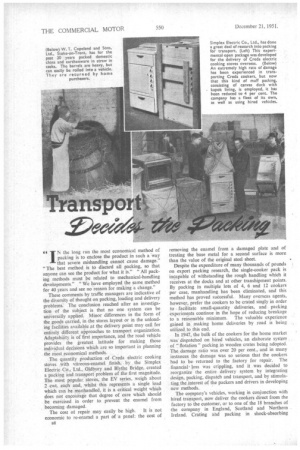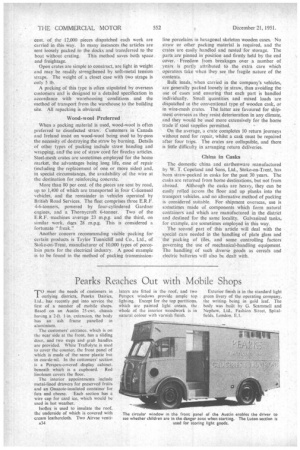How Transport Methods Affect the Kinds of Packing Employed in
Page 43

Page 42

Page 44

If you've noticed an error in this article please click here to report it so we can fix it.
the Delivery of Electric Cooking Stoves, Chinaware 'and Porcelain Electrical Components
Part One
By P. A. C. Brockington, A.M.I.Mech.E.
I
6 6 N the long run the most economical method of packing is to enclose the product in such a -way
that severe mishandling cannot cause damage." "The best method is to discard all packing, so that anyone can see the product for what it is." "All packing methods must be related to mechanical-handling developments." "We have employed the same method for 40 years and see no reason for making a change."
These comments by traffic managers are indicative of the diversity of thought on packing, loading and delivery problems: The conclusion reached after an investigation of the subject is that no one system can be universally applied. Minor differences in the form of the goods carried, in the stores layout or in the unloading facilities available at the delivery point may call for entirely different approaches to transport organization. Adaptability is of first importance, and the road vehicle provides the greatest latitude for making those individual decisions which are so important in planning the most economical methods.
The quantity production of Creda electric cooking stoves with vitreous-enamel finish, by the Simplex Electric Co., Ltd., Oldbury and Blythe Bridge, created a packing and transport problem of the first magnitude. The most popular stoves, the EV series, weigh about 2 cwt. each and, whilst this represents a single load which can be manhandled, it is a critical weight which does not encourage that degree of care which should be exercised' in order to prevent the enamel from becoming damaged.
The cost of repair may easily be high. It is not economic to re-enamel a part of a panel; the cost of removing the enamel from a damaged plate and of treating the base metal for a second surface is more than the value of the original steel sheet.
Despite the expenditure of many thousands of pounds on export packing research, the single-cooker pack is incapable of withstanding the rough handling which it receives at the docks and at other transhipment points. By packing in multiple lots of 4, 6 and 12 cookers per case, manhandling has been eliminated, and this method has proved suecessful. Many overseas agents, however, prefer the cookers to be crated singly in order to facilitate small-quantity deliveries, and • packing experiments continue in the hope of reducing breakage to a reasonable minimum. The valuable experience gained in. making home deliveries by road is being utilized, to this end.
In 1947, the bulk of the cookers for the home market was dispatched on hired vehicles, an elaborate system of " flotation " packing in wooden crates being adopted. The damage ratio was over 20 per cent., and in many instances the damage was so serious that the cookers had to bereturned to the factory for repair. The financial loss was crippling, and it was decided to reorganize the entire delivery system by integrating design, packing, dispatch and transport, and by stimulating.the interest of the packers and drivers in developing new methods.
The company's vehicles, working in conjunction with hired transport, now deliver the cookers direct from the factory to the customer, or to one of the 18 branches of the company in England, Scotland and Northern Ireland. Crating ahd packing in shock-absorbing material has been discontinued. The cookers are carried in a " naked " condition, covered only by a loose muff of canvas duck with kapok lining. This muff can easily be removed for the examination of the unit by the driver or customer.
Any enamel fragments of a broken panel fall to the floor and give immediate notice of damage. After checking that the stove is in factory condition, an acknowledgement of this is readily obtainable from the customer.
The saving in replacement costs has been greater than the most sanguine estimates. The damage ratio has been reduced to 4 per cent. and, as most of the damage is repairable without dismantling, the cost is small.
The fleet is based on Ford Thames chassis powered by Perkins oil engines. The chassis have been fitted with Baico extensions to give the drop-sided bodies an inside length of 17 ft. 6 ins., and the interior width has been increased to 7 ft. 2 ins, by dispensing with the wagon lip arid providing the sides with a special type of exterior hinge. The extra width and the use of muffs increase the load capacity from 41 to 54 units.
Loading Four Cookers at a Time
Most of the home-delivery vehicles are fitted with Burtonwood tailboard hoists, on which four cookers can be loaded. The tailboards have castor fittings, and this feature is invaluable to a driver, working singlehanded, when deliveries are made to country schools and other out-of-the-way places, many of which are some distance from the nearest unloading point.
The drivers are regarded as the most important factor in the delivery system. The first Saturday in the month is "grouse Saturday," when the drivers foregather with the dispatch and transport manager, the dispatch foreman and any interested members of other departments in order to air grievances' and discuss improvements. As observed by a representative of the company, "no punches are pulled or holds barred," and these informal meetings help to dissipate friction between the sales, warehouse and dispatch departments.
An alternative visible-packing method is the subject of the export experiments. The cooker is enclosed in a transparent material, similar to Cellophane, and packed in a timber frame, which leaves most of the cooker open to view. Judging by the arrival in an undamaged condition of visibly packed units at destinations in Ireland, Northern Scotland and the South Coast, the results so far are encouraging.
An interesting change was successfully made in the method of packing stoved-enamel water heaters. These were originally float-packed in wood-wool and corrugated paper, and both the enamel and exposed metal parts suffered from severe corrosion after a period of storage. It was discovered that acids in the wood-wool and paper were responsible for the corrosion, and another packing method had to be found.
A Problem Solved
The solution of the problem was simple. The heaters are now secured to the wooden 'case by means of bolts attached to the heater brackets, with fully compressive Jablex cushioning washers inserted between the brackets and the case. The components are wrapped in heavily waxed paper and the inside of the case is lined with bitumen kraft paper. This method has obviated corrosion and saves the packers' time. In some instances as many as 12 heaters have been packed in the same case, six upstanding on the base and six hanging inverted from the top board.
. Planning and development engineers co-operate closely with the dispatch and transport manager to produce equipment that can be handled and transported with the minimum breakage.
The psychological value of using visible packing, as applied to chinaware and similar goods, was also mentioned by a number of concerns in the Potteries. A large percentage of the sanitary ware produced by Twyfords, Ltd., Stoke-on-Trent, is packed in open cases, which are simple to construct and prevent damage under normal handling conditions.
It is, moreover, impossible for theoperator to plead ignorance of the type of product he is handling and a major breakage is immediately apparent. This also applies to articles loosely packed in straw; up to 40 per cent. of the 12,000 pieces dispatched each week are carried in this way. In many instances the articles are sent loosely packed to the docks and transferred to the boat without crating. This method saves both space . and freightage.
Open crates. are simple to construct, are light in weight and may be readily strengthened by soft-metal tension straps. The weight of a closet case with two straps is only 5 lb.
A packing of this type is often stipulated by overseas customers and is designed to a detailed specification in accordance with warehousing conditions. and the method of transport from the warehouse to the building site. All repacking is obviated..
Wood-wool Preferred
When a packing material is used, wood-wool is often preferred to disinfected straw. .Customers in Canada and Ireland insist on wood-wool being used to by-pass the necessity of destroying the straw by burning. Details of other types of packing include straw banding and wrapping, and the use of straw cord for fireclay articles. Steel-mesh 'crates are sometimes employed for the home market, the advantages being long life, ease of repair (including the replacement of one or more sides) and, in special circumstances, the availability of the wire at the destination for reinforcir4; concrete.
More than 80 per cent. of the pieces are sent by road, up to 1,400 of which are transported in four C-licensed vehicles, and the remainder in vehicles operated by British Road Services. The fleet comprises three E.R.F. 4-6-tonners, powered by four-cylindered Gardner engines, and a Thornycroft 6-tormer. Two of the E.R.F. machines average 23 m.p.g. and the third, on similar work, dues 28 m.p.g. This is considered a fortunate "freak."
Another concern recommending visible packing for certain products is Taylor Tunnicliff and Co,, Ltd., of Sioke-on-Trent, manufacturer of 10,000 types of porcelain parts for the electrical -industry, A good example is to be found in the method of packing transmission
line porcelains in hexagonal skeleton wooden cases. No straw or other packing material is required, and the crates arc easily handled and nested for storage. The parts are pinned in position and firmly held by the end cover. Freedom from breakages over a number of years is .partly attributed to the extra care which operators take when They see the fragile nature of the contents.
Bulk loads, when carried in the• company's vehicles, are generally packed loosely in straw, thus avoiding the use of cases and ensuring that each part is handled individually. Small quantities and mixed loads are dispatched in the conventional type of wooden cask, or in wire-mesh crates. The latter are favoured for shipment overseas as they resist deterioration in any climate, and they would be used more extensively for the home trade if steel supplies permitted.
On the average, a crate completes 10 return journeys without need for repair, whilst a cask must be repaired after four trips. The crates are collapsible, and there is little difficulty in arranging return deliveries.
China in Casks The domestic china and earthenware manufactured by W. T. Copeland and Sons, Ltd., Stoke-on-Trent, has been straw-packed in casks for the past 30 years. The casks are returned from home destinations, but not from
abroad. Although the casks are heavy, they can be easily rolled across the floor and up planks into the transport vehicles, and no alternative method of packing is considered suitable. For shipment overseas, use is sometimes made of components which form natural containers and which are manufactured in the district and destined for the same locality. Galvanized tanks, for example, are sometimes employed in this way.
The second part of this article will deal with the special care needed in the handling of plate glass and the packing of tiles, and some controlling factors governing the use of mechanical-handling equipment. The handling of such diverse goods as cereals and electric batteries will also be dealt with.












































































